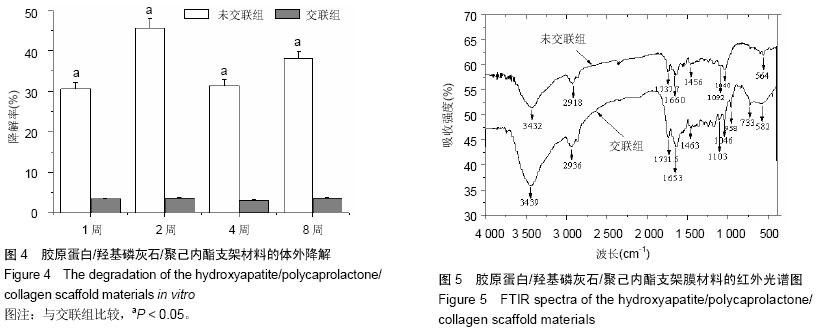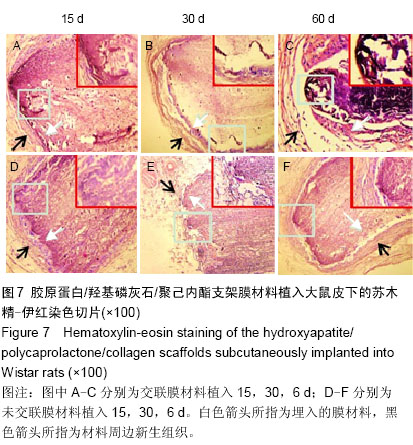1.1 设计 观察性实验。
1.2 时间及地点 于2013年9月至2014年7月在解放军兰州军区总医院骨研所完成。
1.3 材料 骨髓间充质干细胞由解放军兰州军区兰州总医院动物实验科提供。所制诱导性仿骨结构骨组织工程支架材料(分管材和膜材)为本实验室自制,材料规格根据不同实验具体而定,60Co灭菌后备用。
实验动物:清洁级4月龄雌性Wistar大鼠6只,由解放军兰州军区兰州总医院动物实验科提供,许可证号:SYXK(甘)2011-0001,体质量(150±10) g。在实验手术操作过程中,均遵循医学伦理学精神要求。
主要材料、试剂及仪器:鼠胶原蛋白(自猪皮提取);淫羊藿苷(中国食品药品检定研究院);壳聚糖 (浙江金壳生物化学有限公司);羟基磷灰石(西安瑞林生物科技有限公司);聚己内酯、DMEM/F12(Sigma公司);京尼平(和光纯药工业株式会社);胎牛血清(浙江天航生物科技有限公司);冷冻干燥机(解放军军事医学科学院);静电纺丝机(大连鼎通科技发展有限公司);扫描电镜 (日本电子公司);万能力学测试机(日本岛津公司);接触角测定仪(德国Dataphysics公司);酶标仪(美国伯腾仪器有限公司);AVATAR360型傅里叶变换红外光谱仪(美国NICOLET公司)。
1.4 实验方法
胶原蛋白的制备:将100 g猪皮组织切碎后以组织匀浆机匀浆,利用酸法和盐析方法分离胶原蛋白后,4 ℃保存备用。
仿骨结构诱导性骨组织工程支架材料的构建:
载药微球的制备:将250 mg壳聚糖溶解于10 mL 2%乙酸溶液中,后加入40 mg淫羊藿苷混匀,将混合液逐滴(10 mL/2 h)加入至100 mL搅拌状态的石蜡油(含2% Span-80)中;室温下机械搅拌2 h(450 r/min);待上述混合液滴完,再逐滴加入5%三聚磷酸盐25 mL至上述混合液中,继续搅拌2 h至形成稳定的微球颗粒。静置1 h弃上清,2 000 r/min离心30 min,过量石油醚、异丙醇分别洗涤3次,-20 ℃置2 h,-80 ℃置24 h,真空冷冻干燥12 h,密闭封装。
管芯构建:在胶原蛋白中加入载药微球,比例为 3 g/40 L,混均后置特制模具中,-80 ℃预冷2 h,真空冷冻干燥。
外管构建:将羟基磷灰石、聚己内酯与胶原蛋白以质量比0∶3∶3、1∶3∶3、2∶3∶3、3∶3∶3分别混溶于10 mL HFIP中,按顺序电纺,于直径6.0 mm的柱形接收轴上收集成管,每一比例电纺一层,最后制得4层原料比例不同的外管支架,从里到外羟基磷灰石的比例不断加大,是基于这样的考虑:增大羟基磷灰石比例能够提高外管的力学强度,使之有一定的承重能力,内部羟基磷灰石比例较低,有利于支架材料降解。另同等条件电纺复合膜1张用作以下部分实验(注:外管部分性能需以膜的形式进行评价)。电纺条件:电压15 kV,接收距离12 cm,速度1 mL/h,每一比例电纺20 mL,所制外管厚度0.7-0.8 mm。
仿骨结构诱导性骨组织工程支架材料的构建:将管芯置外管内以1%京尼平37 ℃交联1 h,0.01 mol/L PBS清洗3次,-20 ℃预冷2 h,真空冷冻干燥。60Co照射后备用。
体外缓释技术评价管芯中药物的缓释效果:取支架管芯材料3块,置于37 ℃、10 mL 0.01 mol/L PBS中,分别于1,2,4,8,12,24,48,72 h取1 mL缓释液保存待测,并回补1 mL PBS,全部取样完毕,酶标仪检测270 nm处不同时间点吸光度,计算缓释量并绘制药物缓释曲线图。
红外光谱表征外管材料:采用AVATAR360型傅里叶变换红外光谱仪测定交联前后外管材料的红外吸收光谱。
膜材料表面接触角的测定:将电纺复合膜材料剪成大小10 mm×10 mm的5个样品,表面接触测定仪OCA20室温下测试,膜材表面滴定约7 μL的去离子水,多点测试,取平均值。
膜材料透气性测定:取大小相同的小口瓶4只,瓶中加一定量的生理盐水,电纺复合膜的平均透气面积为 1.23 cm2,用膜将瓶口密封(实验组),对照组敞口,电子天平称其质量,置37 ℃恒温箱作用24 h,再次称其质量,实验重复3次,计算其透气性,透气率=实验组24 h失水量/对照组失水量×100%。
膜材料吸水率测定:将电纺支架材料制成5个平行样(6.0 mm×6.0 mm),电子天平称其质量为(m1),然后将其浸泡于去离子水中,37 ℃环境下静置24 h,滤纸轻轻吸去表面水分,称其质量为(m2),计算吸水率(?),? =(m1-m2/ m1)×100%。
膜材料孔隙率测定:在比重瓶中加入10 mL乙醇称得质量为m1,小瓶里加入膜材料后待乙醇将膜材料完全浸没,在乙醇液面处做标记,取出材料后称质量得m2,然后滴加乙醇使液面至标记处,称质量得m3,根据公式计算材料孔隙率:孔隙率=[1-(m3-m1)/(m3-m2)]×100%。
外管材料力学性能测试:取电纺外管材料(直径8 mm、长3 cm)若干,分两组:交联组、非交联组,分别于湿态下于AG-1型号万能材料试验机进行拉伸实验,拉伸速度 5 mm/s,检测其力学性能。
扫描电镜观察膜材料微观结构:取交联前电纺膜材料(3 mm×3 mm)后各1块,制样喷金后在扫描电镜下观察其表面形貌。
仿骨结构诱导性骨组织工程支架材料降解实验:取交联和未交联仿骨结构诱导性骨组织工程支架材料各12块,分别称质量后,置于10 mL 含双抗的PBS中(小瓶封装),37 ℃摇床上慢速摇动,分别于1,2,4,8周取出3块材料,双蒸水浸泡清洗后干燥,称质量,计算失重率,分析交联对支架材料降解性能的影响。
骨髓间充质干细胞与膜材料复合后的增殖:选取密度为1×104/cm2的骨髓间充质干细胞,分别接种于经交联和未交联的膜材料(5 mm×5 mm),静置10 min后加入DMEM/F12完全培养液培养,每周更换2次培养液,分别于3 d和7 d时取出材料,0.1 mol/L PBS冲洗3次,2.5%戊二醛固定液和体积分数10%甲醛固定,分别进行扫描电镜和苏木精-伊红染色。观察骨髓间充质干细胞在材料上的黏附、迁移与形态。
动物实验:取清洁级Wistar大鼠6只,以10%水合氯醛0.3 mg/kg行腹腔麻醉。将交联、未交联膜材料(10 mm× 10 mm)各3块分别埋入大鼠背部皮下,术后15,30,60 d麻醉大鼠取出材料,体积分数10%甲醛和2.5%戊二醛分别固定24 h,行苏木精-伊红染色及扫描电镜观察。
1.5 主要观察指标 仿骨结构诱导性骨组织工程支架材料的物理化学及生物学性能。
1.6 统计学分析 数据用x±s表示,采用SPSS 17.0统计软件进行分析,行卡方检验和t 检验。
中国组织工程研究杂志出版内容重点:生物材料;骨生物材料; 口腔生物材料; 纳米材料; 缓释材料; 材料相容性;组织工程



